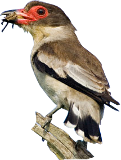| Rare Birds |

|
Below will be a few photos of various rare birds that I have photographed in the U.S. in past years. Please keep in mind that in order to photograph rarities,
the bird photographer must often have to work in less than ideal conditions. Often the distance to the bird may be great, the light at a bad angle, the weather
conditions poor, or the bird is simply not cooperative! Photographing rare birds is a challenge, and all state rare bird committees need as much help as possible
from birders to obtain photo documentation of rarities.
In 1992, I co-authored an article titled "How to Document Rare Birds" which was published in Birding. Even today this article may still be useful
to the field observer. Click here to read the article. Another useful article about the subject is titled "Emerging From the Silent
Majority: Documenting Rarities" by Claudia Wilds and Robert Hilton. This can be found on a page of the Maryland Bird Records Committee
here. Please also see "
How to Write Convincing Details" by Mike Patterson and "On Taking a Notebook Afield"
by Claudia Wilds".
| Terek Sandpiper (Xenus cinereus); 1st California record Long-toed Stint (Calidris subminuta); 1st California record Black-tailed Gull (Larus crassirostris); 1st Texas record Green-breasted Mango (Anthracothorax prevostii) Tufted Flycatcher (Mitrephanes phaeocercus); 1st U.S. record Buff-breasted Flycatcher (Empidonax fulvifrons); 1st Texas record Masked Tityra (Tityra semifasciata); 1st U.S. record White-throated Thrush (Turdus assimilis); 1st U.S. record Slate-throated Redstart (Myioborus miniatus); 1st photographed Texas record & 6th record for the U.S. |
